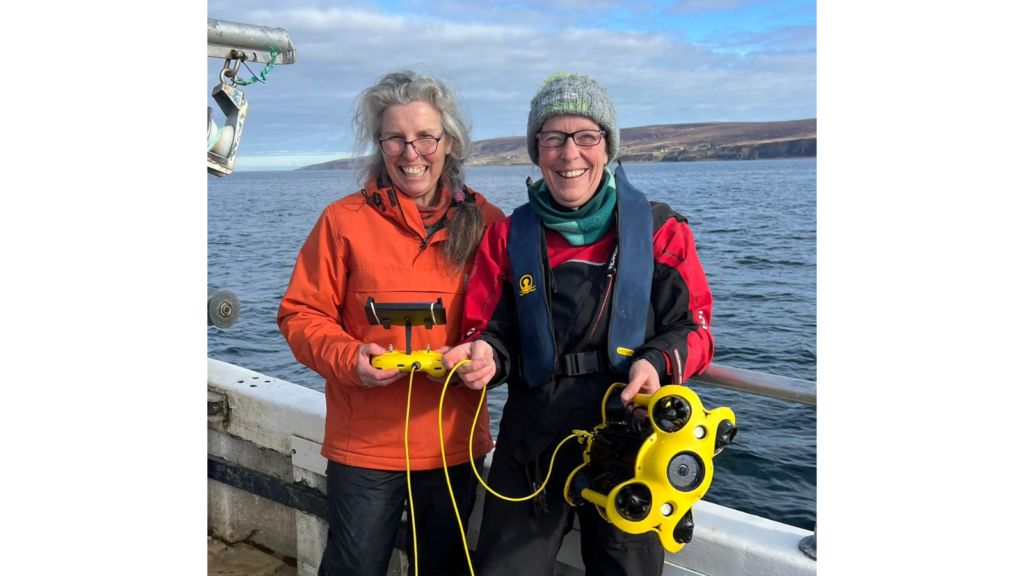A team of national and local citizen scientists have recorded herring spawning on an area of sensitive seabed habitat off the coast of North Erradale, near Gairloch and are calling for urgent protection of the breeding ground of this commercially important fish population.

On March 12th, a team of local scientists found vast areas of herring eggs on maerl gravel northwest of Loch Gairloch using a remotely operated underwater camera. The seabed survey followed reports of unusually high numbers of seabird and marine mammals feeding in the area in the days prior. Satellite imagery showed areas of cloudy turquoise water, caused by herring milt, indicating that a spawning event had occurred.
Shoals of spring spawning herring have been observed along Gairloch’s coastline since 2018, but this is the first time spawning has been recorded in this area of seabed off North Erradale for decades and is significant for the future of west coast herring.
Steve Truluck, photographer at Steve Truluck At Sea and tour guide for Hebridean Whale Cruises who was on board the initial survey said: “We found herring eggs and maerl beds which hopefully will mean that more work can be carried out in order for NatureScot to put in place the necessary protection for this important habitat. These eggs are part of the bigger picture which feeds our whales, which then provide income for local communities, joy for visitors and most importantly the air that we breathe and carbon sequestration in the fight against climate change”
This spawning habitat has no form of fisheries management in place even though the Scottish Government acknowledges that this area of seabed has Priority Marine Feature habitats that deserves protection. Scientific advice recommends that activities negatively impacting herring spawning grounds should not occur. Scallop dredging, a type of fishing which disturbs the top layer of seabed, is known to take place here.
Sue Pomeroy of Little Loch Broom Marine Life said “While it is exciting to see herring spawning taking place here, it is also worrying that these vital spawning habitats are still at risk of being further degraded by scallop dredging. Herring is culturally and historically significant to Gairloch, and recovery of the West Coast stocks and more investment could help revive our once abundant local fisheries.”
Historically, herring was abundant around the West of Scotland and highly important to the local economy. West Coast herring stocks today are unable to support a commercial fishery. Local fishermen have been calling for the Scottish Government to protect herring spawning habitats in these waters for years.
Ian McWhinney, local creel fisherman, said: “On several occasions over the past six years, the creel sector has requested fishing restrictions in these areas in line with ICES advice that herring spawning grounds should not be disturbed by activities such as scallop dredging, but Government has yet to respond. This means we’ve got a 50 mile stretch of coastline that has been identified as important herring spawning grounds with zero conservation or protection in place.”
Calls for protection to Gairloch’s herring spawning areas are joined by a wider call for broader restrictions on inshore bottom trawling and dredging around Scotland’s coastal zone. Our Seas, a coalition of over 130 organisations raising awareness of the urgent need to protect our coastal seabed, argue that reinstating a modern limit on dredging and bottom-trawling, the most destructive forms of fishing used in Scotland’s sensitive inshore waters, would restore biodiversity and feeding, breeding and nursery grounds for fish, whilst at the same time increasing the amount of jobs and income generated by inshore fisheries.
Hayley Wolcott, Coordinator of Our Seas said: “Scotland’s inshore fisheries have been in decline since inshore trawling ban was removed in the 80’s. A vibrant and diverse fishing industry which once caught cod, herring, and whiting now primarily relies on shellfish. If our inshore waters, which provide vital spawning, nursery, and feeding habitats for fish, were protected from high-impact fishing methods, then these vital habitats could recover for the benefit of sustainable fishers, coastal communities and future generations”
Leave a Reply